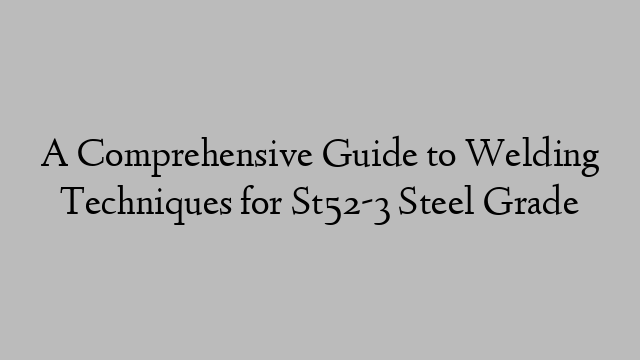Address
304 North Cardinal St.
Dorchester Center, MA 02124
Work Hours
Monday to Friday: 7AM - 7PM
Weekend: 10AM - 5PM
Address
304 North Cardinal St.
Dorchester Center, MA 02124
Work Hours
Monday to Friday: 7AM - 7PM
Weekend: 10AM - 5PM

Specification: A Comprehensive Guide to Welding Techniques for St52-3 Steel Grade
Introduction:
This comprehensive guide aims to provide detailed information about welding techniques specifically applicable to St52-3 steel grade. St52-3 steel is a low alloy, high strength structural steel that finds applications in various industries, including construction and manufacturing. The welding process plays a crucial role in the fabrication and joining of St52-3 steel components, ensuring their structural integrity and performance. This guide will cover the essential aspects of welding St52-3 steel, including mechanical properties, chemical composition, and key considerations during the welding process.
1. Mechanical Properties:
St52-3 steel exhibits excellent mechanical properties, making it suitable for various structural applications. The key mechanical properties of St52-3 steel include:
– Tensile Strength: St52-3 steel has a minimum tensile strength of 490-630 MPa, depending on the thickness of the material.
– Yield Strength: The minimum yield strength of St52-3 steel is 355 MPa.
– Elongation: St52-3 steel offers a minimum elongation of 22% in 50mm.
– Impact Strength: St52-3 steel possesses good impact resistance, with a minimum impact strength of 27 J at -20°C.
Understanding these mechanical properties is vital in selecting appropriate welding techniques and ensuring the structural performance of welded St52-3 steel components.
2. Chemical Composition:
The chemical composition of St52-3 steel typically comprises the following elements:
– Carbon (C): St52-3 steel contains carbon ranging from 0.20% to 0.24%, contributing to its strength and hardness.
– Manganese (Mn): Manganese content in St52-3 steel ranges from 1.60% to 1.90%, enhancing its toughness and wear resistance.
– Silicon (Si): The silicon content in St52-3 steel is typically around 0.55%, facilitating deoxidation and improving mechanical properties.
– Phosphorus (P): St52-3 steel contains phosphorus levels of up to 0.035%, ensuring good weldability.
– Sulfur (S): Sulfur content in St52-3 steel is limited to a maximum of 0.035% to maintain desired mechanical properties.
– Other Elements: St52-3 steel may also include small amounts of other elements such as copper (Cu), nickel (Ni), chromium (Cr), and molybdenum (Mo) based on specific requirements.
Understanding the chemical composition of St52-3 steel enables welders to determine proper welding procedures and select suitable filler materials for achieving high-quality welds.
3. Welding Techniques:
Welding St52-3 steel requires careful consideration of various welding techniques and parameters to ensure optimal weld quality and joint integrity. Some of the commonly used welding techniques applicable to St52-3 steel include:
– Shielded Metal Arc Welding (SMAW)
– Gas Metal Arc Welding (GMAW/MIG)
– Flux-Cored Arc Welding (FCAW)
– Submerged Arc Welding (SAW)
– Gas Tungsten Arc Welding (GTAW/TIG)
This guide will provide detailed instructions on each welding technique, including recommended welding processes, electrode/filler wire selection, preheating/post-weld heat treatment requirements, and post-weld inspection procedures. Additionally, it will address important considerations such as joint design, welding positions, and potential welding defects associated with St52-3 steel.
Conclusion:
By following the guidelines presented in this comprehensive guide, welders and fabricators can effectively weld St52-3 steel, ensuring high-quality welds with proper joint integrity. Understanding the mechanical properties, chemical composition, and appropriate welding techniques for St52-3 steel is crucial in achieving reliable and durable welded structures.
St52-3 Steel grade
1698785132